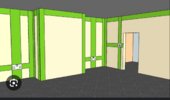I have used wall chasers in carpeted houses.
Mine is a cheapo Titan one from Screwfix. I connect it to one of my Festool dust extractors. Dust is pretty minimal provided that you go sufficiently deep the first time. It you make the mistake of not going deep the first time, if you do a second run, the dust will shoot out of the slots. You do get a bit of dust as you first plunge in but once the base of the tool is flat with the wall, there really is very little dust.
The Titan includes a tool (read:chisel) to snap out the brick and plaster.
A downside is that, because of the length of the tool, you will only be able to start the channel about 20cm up from the floor.
An advantage is that because it had two blades, the slots are guaranteed to be parallel.
Mine is a cheapo Titan one from Screwfix. I connect it to one of my Festool dust extractors. Dust is pretty minimal provided that you go sufficiently deep the first time. It you make the mistake of not going deep the first time, if you do a second run, the dust will shoot out of the slots. You do get a bit of dust as you first plunge in but once the base of the tool is flat with the wall, there really is very little dust.
The Titan includes a tool (read:chisel) to snap out the brick and plaster.
A downside is that, because of the length of the tool, you will only be able to start the channel about 20cm up from the floor.
An advantage is that because it had two blades, the slots are guaranteed to be parallel.


